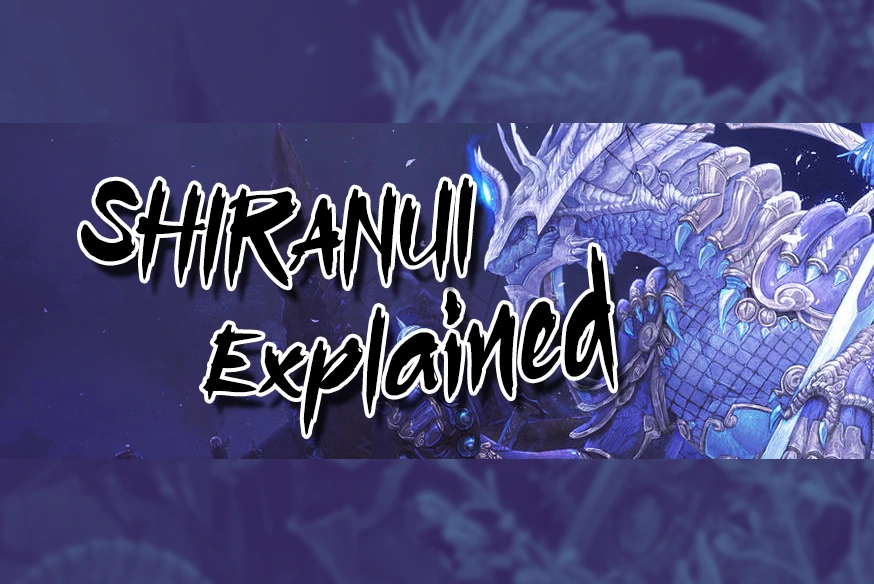
Shiranui: In-Depth Analysis
Introduction
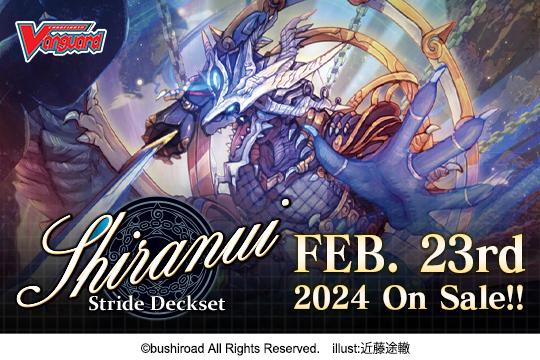 With the Stride Deckset Shiranui coming out in February, there has been lots of discussion about the cards included in the product, and how to include them in the current version of Nubatama in the Premium format. I want to add my own two cents on the matter, and give those who know only about one format some insight into the other.
With the Stride Deckset Shiranui coming out in February, there has been lots of discussion about the cards included in the product, and how to include them in the current version of Nubatama in the Premium format. I want to add my own two cents on the matter, and give those who know only about one format some insight into the other.
This article is divided into two parts. In the first part, I want to go over some of the history of Nubatama in Premium. The clan has seen a lot of change, so it helps to go over the context of the clan’s current state before exploring what new options are available. The second part will cover deckbuilding, and go over some card options to round out the deck. If you are unfamiliar with Nubatama, hopefully this article should serve as a mini-primer to learn the deck.
While the Crest has an interesting history in Premium with Chronojet and Messiah, Shiranui is a different beast. I argue that in the past year, Shiranui’s primary strengths have started to shift due to changes in Premium's environment and Nubatama’s card pool. As a result, the accommodations needed for a Crest-centered deck are easier to do than others make it out to be.
Part 1: Quick History of Nubatama
When you’re building a deck, you should bring things back to the basic rules of the game: you need to deal six damage to the opponent. You can only deal damage if your opponent chooses not to guard with cards in their hand. So, what does your deck do which gets through the opponent’s hand? Where other decks gain power which may translate into the opponent guarding with one more card, or an extra attack requiring another card to guard with, Nubatama has a very straightforward answer: they force the opponent to discard through abilities. A simple, direct -1.
However, there is a careful balance that Bushiroad had to walk when designing Nubatama in Vanguard’s first couple of years. When you increase power or stand a unit again, your opponent can always choose how they want to guard, or whether they want to guard at all. Players are given a choice in how they respond. Discarding naturally reduces options, and in excess leaves the opponent totally helpless without any counter-play. In the beginning decks did not have the aggressive card draw that they have now, so for a long time discarding was avoided and Nubatama was binned.
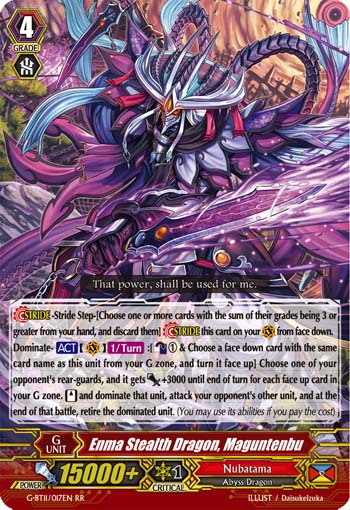 This left Nubatama with a laughably small card pool. They were introduced in Descent of the King of Knights, the game’s first booster set, but it took until Catastrophic Outbreak (over two years) before they got any updated support, and even after that support was sparse. To try to flesh out the clan’s identity, Nubatama was given many weird mechanics to play with; they’re similar to Link Joker in that way.
This left Nubatama with a laughably small card pool. They were introduced in Descent of the King of Knights, the game’s first booster set, but it took until Catastrophic Outbreak (over two years) before they got any updated support, and even after that support was sparse. To try to flesh out the clan’s identity, Nubatama was given many weird mechanics to play with; they’re similar to Link Joker in that way.
- In the second year of G, every clan received a unique keyword ability. Nubatama got the Dominate keyword (nobody cares about afterimage), where you attack your opponent with their own units. This gives the clan pseudo-multi-attacking, and the potential to use the opponent’s abilities against them.
- In an attempt to balance discarding, V Series Nubatama either forced the opponent to discard after returning their rearguard to hand (bouncing); or made them discard and draw, usually with an additional effect based on what was discarded. The bounce and discard is technically a -1, but not as effective as straight up retiring or binding something like other clans. Nubatama can also bounce their own rearguards to hand, tying the theme together.
- Akatsuki Hanzo brought to the clan Evil Decoy Tokens: grade 0 rearguards which could intercept from the back row, but not boost. On their own they give some early defense, but were also used like plant tokens as the cost for abilities. In current lists, the token-based units have given the clan a useful middle-game, but never brought any finishing power.
The Win Button
Because Nubatama is a designated “control” clan, they were never given any solid, aggressive cards. You could technically count Dominate as a multi-attack mechanic, but their attacks were nothing close to what other clans could do who were designed to be aggressive. That would be fine if their control mechanics were strong. But, out of fear of its strength, Nubatama’s control game was lackluster and underdeveloped. Evil Decoy tokens aren’t a robust defensive mechanic either; it’s just an extra 5000 shield. A pessimistic read is that outside of discarding, anything Nubatama can do another clan can do better. If you’re just a guy who likes his cool ninja dragons, what are you meant to do?
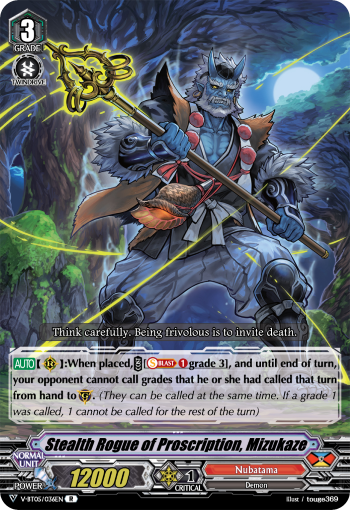 Well, V Series is arguably the most experimental that Bushiroad has ever been in card design. The term “Battledore” to refer to forcing the opponent to guard with two or more cards at the same time refers to Battledore Fighter, which debuted in V-BT01. V is an era of the game partially defined by the various guard restrict abilities printed. In particular, Protect clans were given powerful grade 3 finisher cards to reward their defensive playstyle with a payoff. Nubatama got four: one is banned; two require a little too much set-up; which leaves Stealth Rogue of Proscription, Mizukaze.
Well, V Series is arguably the most experimental that Bushiroad has ever been in card design. The term “Battledore” to refer to forcing the opponent to guard with two or more cards at the same time refers to Battledore Fighter, which debuted in V-BT01. V is an era of the game partially defined by the various guard restrict abilities printed. In particular, Protect clans were given powerful grade 3 finisher cards to reward their defensive playstyle with a payoff. Nubatama got four: one is banned; two require a little too much set-up; which leaves Stealth Rogue of Proscription, Mizukaze.
When you call him, you soul-blast a grade 3, and for the turn the opponent cannot call cards with the same grade as things they have already called. Guarding is calling from hand to guardian circle, so if they guard with a grade 1, they can no longer guard with grade 1 units after that battle.
In Premium, what makes Mizukaze a threat are cards which force the opponent to call something before the battle phase. This is where Shiranui comes in. On turn 4, you can call a grade 0 from your opponent’s drop zone with Demon Stealth Dragon, Shiranui “Oboro” (which I will just call Oboro), then use Stealth Dragon, Fuurai to call a grade 1. Now the only things your opponent can guard with are 5000 shield grade 2s and grade 3s from hand. If you can set it up, it could effectively put your opponent into a lock where they can't guard anything. It doesn’t matter if the opponent has a bunch of cards in their hand: they could virtually have 0 if you play it right.
Since his debut, Mizukaze has been a two-of staple in Premium Shiranui. After calling your opponent’s cards against their will, you fire Mizukaze and it doesn’t matter how small Nubatama's attacks normally are. For this play to be effective, you need to meet two conditions:
- Your opponent must be at four or more damage, so that at least one of your attacks need to be guarded.
- You need ways of getting grade 3s into soul for Mizukaze’s cost.
 One of the more effective ways of meeting the first condition is to use the token package in late V Series. Typically, what you’d do is use Stealth Dragons Yamishibuki or Gyokusen to call tokens on turn 2 or 3 for defense, then use the token-focused G unit Jakumesso as your first stride. Jakumesso draws cards, swings for 36000 and 2 critical, and lets you eek out another attack, so he provided a solid way of getting the opponent to a good damage range while finding your pieces.
One of the more effective ways of meeting the first condition is to use the token package in late V Series. Typically, what you’d do is use Stealth Dragons Yamishibuki or Gyokusen to call tokens on turn 2 or 3 for defense, then use the token-focused G unit Jakumesso as your first stride. Jakumesso draws cards, swings for 36000 and 2 critical, and lets you eek out another attack, so he provided a solid way of getting the opponent to a good damage range while finding your pieces.
To get grade 3s in soul, Nubatama actually has a decent number of cards to help with that. V Series Shiranui (which I will just call Shiranui) is a rearguard which will swing for 22000 if you have a “Shiranui” vanguard like Oboro, so you get some solid pressure on turn 3. After the battle he puts himself into soul and draws a card, so you get the grade 3 for Mizukaze and you don’t need to have another Oboro in hand to ride over. Also, by going first, you can use Shiranui’s vanguard skill and superior ride Oboro from the deck; now you have a grade 3 in soul, easy as pie.
To find your grade 3 units, Nubatama has a wealth of selection options. There’s Unen, which can search whatever you’re missing when rode upon; Katarigitsune which can catch Shiranui, Mizukaze, or heal guards if you need them; and if you’re into it you could play Tobiitachi to grab either Oboro or Shiranui. There are also some cards from overDress which send specifically “Stealth” units into soul.
Nubatama in 2024
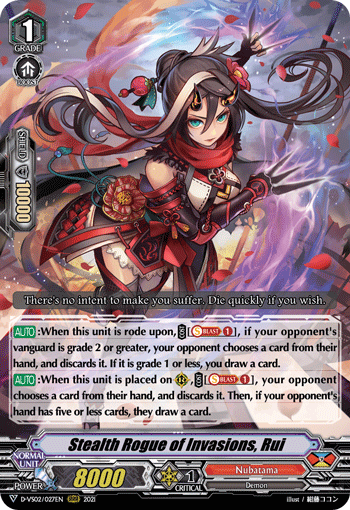 So far I have basically just given a mini-primer of Shiranui with Mizukaze. Since Mizukaze’s introduction, several new features to Premium have been added which work against him.
So far I have basically just given a mini-primer of Shiranui with Mizukaze. Since Mizukaze’s introduction, several new features to Premium have been added which work against him.
First, before even discussing newer cards, every clan has a universal option against Mizukaze through G guards. Because Mizukaze only prevents calling from hand, G guards called from the G deck bypass his guard restriction. Since Nubatama can only usually perform three attacks (excluding dominated units), your opponent can reasonably survive if they are not at five damage.
Second, the G unit which maximizes Mizukaze’s value is Evil-eye Vidya Emperor, Shiranui “Rinne”, which forces the opponent to call two units from hand and attack one at a time. His effect combines both the discard and Dominate mechanics unique to Nubatama, and is the clan’s best G unit. The cards called by Rinne count toward Mizukaze’s restriction, so the two together were usually what killed the opponent. However, V introduced the Quick Shield and the Protect imaginary gift: these are not unit cards, so if the opponent calls them through Rinne, they disappear before ever entering the rearguard. Every clan can get a Quick Shield when they go second (and now a Guardian Shield with Harmonics Messiah), so half of the time the Rinne-Mizukaze synergy is nonexistent.
Third, in the second year of overDress we got Elementaria Sanctitude, a perfect guard which you can play for free if the opponent’s vanguard has Triple Drive. In Premium, where each player strides a unit with Triple Drive every turn, this became is a staple order played in basically every deck. Because it is a blitz order, which you don’t call to use, it also bypasses Mizukaze’s restriction. Along with the various defensive mechanics unique to different clans, Premium has undergone major defensive creep in the past couple of years which have eroded Mizukaze’s threat.
While these are factors outside of Nubatama which work against Mizukaze directly, there have also been additions to the clan’s card pool which further call his inclusion into question. At the start I mentioned that one of Nubatama’s weaknesses was that its straight discarding was neutered very early on. As a result, Mizukaze became the deck’s main win condition to make-up for the deck’s subpar mechanics. Keep this in mind.
First, in 2021 released V Clan Collection Vol.2, which gave us Stealth Rogue of Invasions, Rui. Her primary skill forces the opponent to discard for just a soul-blast. What makes her special is that she is the first generic piece of plain discarding the clan received in V Series. The only other cards before her which do a direct discard are Kujikiricongo and Jamyocongo: both vanguards, and the latter is banned in Premium. The deck finally got a 10000 shield, 8000 power grade 1 which could directly discard, as long as the opponent had seven or more cards in hand.
Then, in 2024, Nubatama got a 1-2 punch in Seiengeki and Gedatsurakan. Seiengeki is part of a “ride fixer” cycle of cards, where you can discard them early to add a grade 0-2 to hand. However, its other ability makes it useful from turn 2 and on: for just a soul-blast, the opponent discards if they have four or more cards in hand.
Imagine it. Your opponent rides up to grade 1, they draw a card from their starter, then swing and drive check. That’s seven cards in hand. That means Rui will always go off by turn 2, and calling Rui behind Seiengeki lets you rip two cards out of the opponent’s hand, putting them from seven to five cards on top of any other cards you happen to call to attack.
On turn 3, you ride up to Oboro. The opponent’s got six cards in hand after drawing, riding, and drive checking. Gedatsurakan is part of another cycle of G units which allow you to stride while the opponent is on grade 2 and you get two Imaginary Gifts, but require you to ride a specific grade 3. Conveniently, that happens to be Oboro. So you superior stride into Gedatsurakan, call another Rui or Seiengeki and make them discard to five, swing with Gedatsurakan for 26000 and triple drive while they’re at grade 2, and then an unconditional discard down to four.
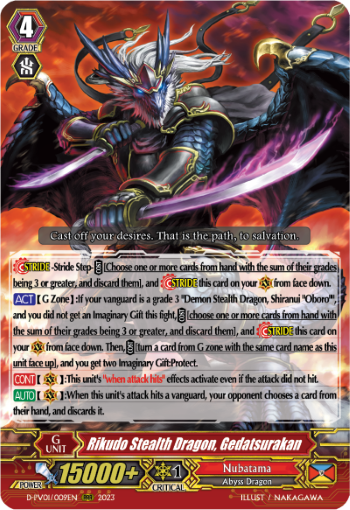 “But what about the Quick and Guardian Shield?” Remember that the best counter-play against Shiranui “Rinne” is to call both of the Shields for his ability. Because they are orders, they never enter the field, immediately disappear, and prevent two dominates. However, if your opponent knows this, then that means when you force them to discard, their best plan is to discard everything but the Shields prior to Rinne. You can safely ignore them because your opponent will never use them if they’re smart. Two of the cards in their actual hand are probably a grade 3 and a card to pay for stride cost, so the remaining cards are either high-shield (meaning they have no aggressive counter-play), or are low-shield rearguards which means the opponent cannot guard your attacks well. By turn 3, they are effectively in top-deck mode.
“But what about the Quick and Guardian Shield?” Remember that the best counter-play against Shiranui “Rinne” is to call both of the Shields for his ability. Because they are orders, they never enter the field, immediately disappear, and prevent two dominates. However, if your opponent knows this, then that means when you force them to discard, their best plan is to discard everything but the Shields prior to Rinne. You can safely ignore them because your opponent will never use them if they’re smart. Two of the cards in their actual hand are probably a grade 3 and a card to pay for stride cost, so the remaining cards are either high-shield (meaning they have no aggressive counter-play), or are low-shield rearguards which means the opponent cannot guard your attacks well. By turn 3, they are effectively in top-deck mode.
Because of the intense amount of discard Nubatama has now, and its sudden turn 2 and 3 pressure on the play, Shiranui can realistically kill by just plowing through the opponent’s thin hand and reducing the opponents’ counter-play. They got their old weapon back. If you look at Top 8 results for Bushiroad Championship Series 2024, the effect this has had on Nubatama’s performance is clear: Shiranui has 10 appearances in top cut across the season, compared to 7 Dailiners, 10 Katrinas, 11 Highlanders, 13 Gredoras, 15 Nightroses, and 15 Chaos Breakers. Ignoring the outlier in Eradicators, which topped 34 times, Shiranui has appeared about as much as other meta contenders. It’s the most competitively viable the clan’s ever been, and we can attribute that to its new discard engine.
Let’s look at Mizukaze again. In theory, he is most effective when the opponent has a ton of cards in hand, because he lets the player ignore most of it when attacking. “It doesn’t matter how many cards they have if they can’t play them.” However, this assumption has become increasingly untrue as the Premium format experiences increasing defensive creep.
At the same time, Nubatama has gotten increasingly better at creating the situation where Mizukaze is weakest: when the opponent’s hand is smaller. The two main deck units which drive this strategy fight Mizukaze for soul. To superior stride Gedatsurakan you must not have gained an Imaginary Gift, which means no superior ride with Shiranui, and you have to discard a grade 3 specifically so there are less you can put into soul. What’s the point in setting this combo up and holding resources for Mizukaze when he isn’t the main factor in winning?
Stride Deckset Shiranui
 Introducing D Special Series 09: Stride Deckset Shiranui, a product for Standard. The Stride Deckset series have had a controversial impact in Premium mainly because of the Crest:
Introducing D Special Series 09: Stride Deckset Shiranui, a product for Standard. The Stride Deckset series have had a controversial impact in Premium mainly because of the Crest:
This is a card that you can get at the beginning of the game which is intended to let you play Premium in Standard. To acquire it, you have to ride a unit which specifically creates it. For Nubatama, that is Stealth Dragon, Seizui. One downside is that Seizui is a 5000 shield grade 1 where most in Premium have 10000, and any copies you draw after turn 1 are vanilla. Because there is no ride deck, to maximize your chances of getting the Crest you’ll want to run a full playset of Seizui, which takes up deck space.
However, the reward of getting the Crest make it worth the risk. Seizui lets you draw a card on top of getting the Crest, so you get a +1 for your trouble. Beside Oboro being a 13000 power base instead of 11000, the main benefit of the Crest is that your front row gets +5000 power for every face up card in your G zone.
Let’s lay it out: if you successfully stride and flip a card in your G zone from cost (which most G units do), then your front row gets +5000 on turn 3, +15000 on turn 4 (from the G unit returning to G zone), +25000 on turn 5, and so on. If you ever G guard, that is another permanent +5000 to the front row. You’re effectively putting three Force markers on your front row per turn. If you know about Luard in V or Highlander in Premium, it’s the same level of power generation.
When you ride Seizui, Nubatama’s historically weak power output disappears, and gets better the longer the game goes on. This incentivizes the player to turn the game into a war of attrition, which is perfect for Rui, Seiengeki, and Gedatsurakan. Seizui pops the deck up from its current tier 1.5 position to potentially one of the best decks in the format. The biggest fear for players using a Crest is whether you can ride him consistently; but with Seiengeki’s ride fixing skill, the odds of riding Seizui are more than 50%. In the games you don’t, you are still playing the same competent deck as before.
And I haven’t even gotten to the restanders.
The Restanders
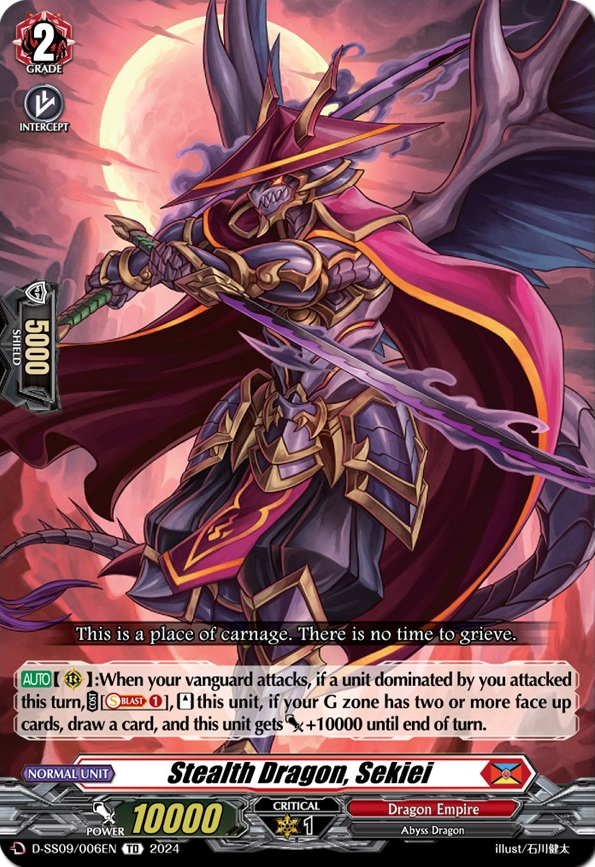 The Stride Deckset also includes four copies each of Stealth Dragon, Sekiei and a new Fuurai, which both restand for a soul-blast if you dominated something that turn. Fuurai gets constant power for every dominate that turn, while Sekiei has to wait for the power until his second attack and at least GB2, but you also get to draw a card. Whether Fuurai or Sekiei is better on a Rinne turn depends on whether or not your opponent has Shields to call.
The Stride Deckset also includes four copies each of Stealth Dragon, Sekiei and a new Fuurai, which both restand for a soul-blast if you dominated something that turn. Fuurai gets constant power for every dominate that turn, while Sekiei has to wait for the power until his second attack and at least GB2, but you also get to draw a card. Whether Fuurai or Sekiei is better on a Rinne turn depends on whether or not your opponent has Shields to call.
They’re better than each other in different situations, but they both have the ability to abuse the power boost from the Crest, and bulldoze over the opponent’s hand. Even better, they still work without Seizui: Fuurai makes for a solid attacker upfront which can hit over damage triggers, while Sekiei can peck at rearguards while allowing you to farm hand. On their own, they serve as solid pieces in the deck’s grade 2 lineup, but become monsters when pumped with Crest power.
¿Por Qué No Los Dos?
Premium Shiranui gets a massive power bump from these new cards in late February. Because the cards in the Deckset are almost designed to fix the problems Nubatama historically had and complement the deck’s current discard engine, I think it’s safe to say they are staples in Premium. They will be played, so there’s a question we need to answer before we move on: how well do they work with Mizukaze?
On the surface level, more attacks means more battles, which means Mizukaze scales better with every restander you have. The power boost from Seizui also means that your opponent will usually only be able to G guard. However, Mizukaze was already making its way out because he does not synergize well with its newest cards. If there are areas where Mizukaze conflicts with the Deckset cards, it makes more sense to take him out than to try to make them both work.
The biggest source of conflict is the soul: Seiengeki and Rui already use a lot of soul to fuel the deck’s discard engine. Now, both of the restanders require a soul to work, and you will stand the same card again over multiple turns. If you have one soul left and the opponent has only four or five cards in hand, which is more effective?
- A 30000+ rearguard’s second swing
- A guard restrict which likely won’t work
Nine games out of ten, it will be the former. Rather than using soul engines like Unen, Shiranui, and others to fuel Mizukaze, that soul will likely be better allocated toward an aggressive push which can be used earlier and often. Combined with Gedatsurakan’s stride conditions, playing Mizukaze means bending over backwards to set up a payoff which isn’t worth it.
All that said, I do also understand the value of a bomb which you can play while you’re behind. There will be games where you are unable to destroy the opponent’s hand because you just don’t draw those cards. If your opponent gets ahead, Mizukaze is perfect for swinging the game back in your favor. The stars need to align, but they do align sometimes. If you play Mizukaze with the Deckset support, he is a B-game which you can play toward when your A-game of tearing apart the opponent’s hand isn’t working.
Part 2: Deckbuilding
Given that Seiengeki will often be discarded for a grade 1, it makes sense to up the number of grade 2 units in the deck to compensate. The baseline number of grade units is 11, so running 12 or even 13 would work. I think a barebones skeleton of the main deck would look like this:
Stealth Dragon, Madoi (V Series) - 1
Elementaria Sanctitude - 1
Stealth Dragon, Eizan - 4
Stealth Dragon, Noroi - 4
Stealth Beast, Mijingakure (V Series) - 3
Dragon Deity King of Resurgence, Dragveda - 1
Shura Stealth Dragon, Mumyocongo - 4
Demon Stealth Dragon, Shiranui "Oboro" - 4
(generic grade 3)
Stealth Dragon, Seiengeki - 4
Restander (Fuurai or Sekiei) - 4
(generic grade 2) - 4
Stealth Dragon, Madoi (D Series) - 4
Stealth Rogue of Invasions, Rui - 3
Stealth Beast, Katarigitsune (either V or G) - 2
(generic grade 1)
Obviously the numbers for specific cards are the bare minimum.
Grade 3s
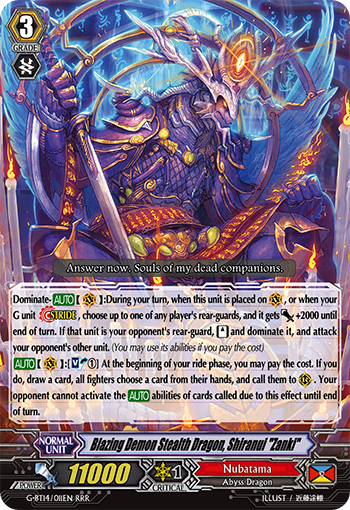 One thing I haven’t mentioned about the Crest is the clause which restricts you from riding units without “Demon Stealth Dragon, Shiranui” in the name. Unless you have a way of directly searching for Oboro, you risk not being able to ride up to grade 3 at all. You cannot G assist for Oboro if you already have a grade 3 in hand, either. This means either running something which can search for Oboro directly, or running something with the “Demon Stealth Dragon” title.
One thing I haven’t mentioned about the Crest is the clause which restricts you from riding units without “Demon Stealth Dragon, Shiranui” in the name. Unless you have a way of directly searching for Oboro, you risk not being able to ride up to grade 3 at all. You cannot G assist for Oboro if you already have a grade 3 in hand, either. This means either running something which can search for Oboro directly, or running something with the “Demon Stealth Dragon” title.
Blazing Demon Stealth Dragon, Shiranui “Zanki” hasn’t seen a lot of play, but because of the ride restriction clause I believe he will have to be looked at seriously as an option. Personally, I don’t think “Zanki” is that bad a unit, since he works as a post-Oboro option turn 4 to get more dominate attacks in. This also means another +5000 to Fuurai, too. As a back-up ride, he’s not bad if you get the on-ride dominate, and by turn 4 the ability to force the opponent to call sets you up for an aggressive push turn.
If you would rather run V Series Shiranui as your off grade 3, then you’d also want to run the old Katarigitsune to search for Oboro directly. The works wonders for ride consistency, as long as you have another grade 3 in hand. The catch is his low numbers; 5000 shield, 7000 power in Premium is a tough pill to swallow. The deck already runs four copies of Seizui which is 5000 shield and vanilla. Preferably you would run V Katarigitsune for his 10000 shield and the ability to search for heal guards, but the odds of riding Oboro are lower. Zanki helps compensate for this and gives you another potential ride target. Yet, that’s not useful going first, where going into Gedatsurakan is important for tempo.
There are numerous pros and cons to running Zanki, Shiranui, or both, but the choice of grade 3 is tied to the choice of Katarigitsune. No matter what, you have to reckon with the risk and reward of each searcher.
Grade 2s
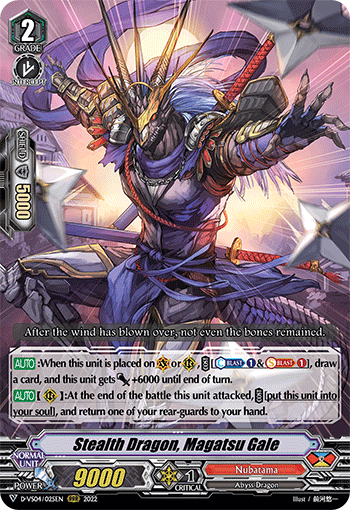 As good as Fuurai and Sekiei are, it isn’t the best idea to run eight restanders in the deck. Seiengeki is a great vanguard, but you will be discarding him a good percent of the time to fetch either Seizui or Katarigitsun. Your most common ride will be a restander as a result. To retain some tempo we can include a grade 2 with a vanguard skill, but that means taking a restander out.
As good as Fuurai and Sekiei are, it isn’t the best idea to run eight restanders in the deck. Seiengeki is a great vanguard, but you will be discarding him a good percent of the time to fetch either Seizui or Katarigitsun. Your most common ride will be a restander as a result. To retain some tempo we can include a grade 2 with a vanguard skill, but that means taking a restander out.
Because Rui is integral to the deck’s strategy, and Katarigitsune is useful at multiple points in a game, ideally some of that grade 2 space should have a dedicated bounce effect. Magatsu Gale is the classic option, but Yamishibuki and (IMO the best vanguard pick) V Series Fuurai have their bounce built into their abilities and both work on vanguard. You just need to be careful with the latter, since you can only run four of either him or D Fuurai in the same deck.
As a higher risk, higher reward option, Shojodoji is easily creates the most raw value. A free selective soul charge and call of anything in our deck for no cost is extremely powerful. However, he only works as a vanguard, so any copies you draw later in the game are dead. Prior to 2024 this isn’t much to sweat over. However, we are already including four virtual vanillas with Seizui, so it might be a bad idea to have two or three more dead cards floating around in the deck.
Grade 1s
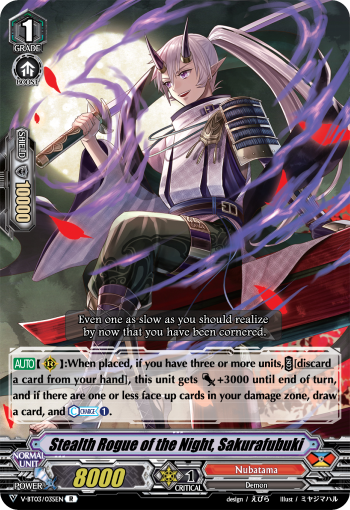 The rest of the room for customization comes in the grade 1 lineup. Given that every relevant G unit we run counter-blasts, if you run a grade 2 unit which uses damage it would be prudent to run some counter-charge. However, there are a couple of other options which could help round out the deck’s tactics.
The rest of the room for customization comes in the grade 1 lineup. Given that every relevant G unit we run counter-blasts, if you run a grade 2 unit which uses damage it would be prudent to run some counter-charge. However, there are a couple of other options which could help round out the deck’s tactics.
Sakurafubuki is the typical option; his stats are standard for Premium, and his counter-charge gets the job done. The most important advice I have is that he’s not a unit you can play as haphazardly as the other two counter-chargers. You need to pay extra attention to keeping him in hand when you G guard, since his CC can be used to cover the cost of Moreilord or Gehourakan, and you don’t want to be stuck with no counter-blast for Rinne. Also, consider if you absolutely need the counter-blast right then, or if you can afford to wait a turn for a better opportunity.
Tengai is a really good alternative option, since he gives both soul and counter-charge in one card. He can’t really go into a deck with G or D Katarigitsune, since the dip in shield will become a liability, but in a deck with V Katarigitsune, the extra soul from his skill is welcome. Be mindful of his 7000 power when you call him to boost.
If you don’t think the counter-charge is necessary, Unen still works well on rearguard. His skill to send the unit he boosts to soul is less relevant for Mizukaze, since he doesn’t aid in the deck’s main strategy, but to say Unen is useless because of that would be throwing the baby out with the bathwater. He sends something to soul, which is absolutely relevant because the deck as a whole became more soul-heavy. G and V Katarigitsune and Rui are both on-place, so Unen can let us abuse those skills while getting resources.
The only thing you have to be careful with is the rearguard used for his cost: you don’t want to send a restander to soul unless you know you can call another. Regardless, Unen empties three rearguard circles, so one copy can reset your board and lets you change formations on a dime.
Hagakure is a Murakumo Nubatama veteran who copies the power and shield of another unit on board. On your turn, Hagakure can copy the power of your vanguard to become 28000, but let’s not forget the Crest. If you target your vanguard while you have the Crest, the power boost effectively doubles for whatever column Hagakure is in since both he and the unit in front of him will get the bonus. Be careful not to call him to the front row first: he will add the Crest’s power, then adjust to match another unit, so if he moves to a back row his power his will decrease.
As a defensive unit, calling Hagakure on top of Moreilord will yield shield that could probably two-card guard Unibird Galaxy under the right circumstances. At the very least, he’s another 15000 shield which you can run which helps compensate the lack of shield from Seizui. However, he is a grade 0, so run more searchers and early card draw to help compensate for the dip in ride consistency.
He’s at most a two-of. If you run him at all, make sure you also have some other unit which bounces something to hand like Yamishibuki or Magatsu Gale. That way, you can use him two turns in a row for huge back-to-back rearguards, or to double-up as an aggro and defensive piece. He may fit the best with Magatsu Gale, since calling him behind the vanguard or a restander means potentially unbalancing your front row’s power.
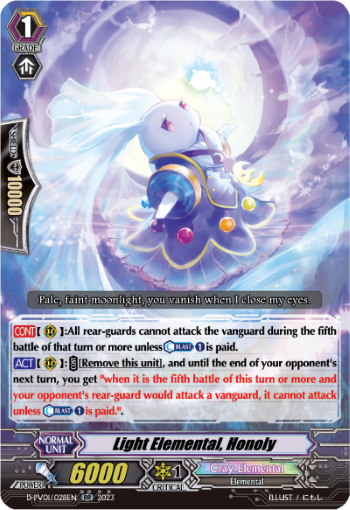 You can’t play Premium and not talk about Honoly. While it’s on the board, players must pay a counter-blast for the 5th battle or more of that turn, if it’s a rearguard aimed at the vanguard. By removing it from play, this tax is only imposed on the opponent for the next turn. It is a commonly played floodgate because of the high volume of attacks some decks can create. Honoly’s value is directly correlated to the current meta, so use your own judgement with whether you use it or not. It’s worth noting that because this deck isn’t combo-oriented and can amount a decent offense with very few cards, you don’t suffer much from your hand getting torn through (at least, not as much as one which needs to call multiple cards to work). Therefore, there’s no incentive to run more than two copies of Honoly.
You can’t play Premium and not talk about Honoly. While it’s on the board, players must pay a counter-blast for the 5th battle or more of that turn, if it’s a rearguard aimed at the vanguard. By removing it from play, this tax is only imposed on the opponent for the next turn. It is a commonly played floodgate because of the high volume of attacks some decks can create. Honoly’s value is directly correlated to the current meta, so use your own judgement with whether you use it or not. It’s worth noting that because this deck isn’t combo-oriented and can amount a decent offense with very few cards, you don’t suffer much from your hand getting torn through (at least, not as much as one which needs to call multiple cards to work). Therefore, there’s no incentive to run more than two copies of Honoly.
Here is as good a place to mention that dominated units do count toward the number of attacks you’ve performed that turn. If your opponent played Honoly on their turn, you have to factor that into your attack pattern and whether you use Fuurai’s or Sekiei’s skill. Sekiei is better against Honoly, since you can swing with your vanguard first and still get +10000 and a draw.
Triggers
Nubatama doesn’t have that many interesting triggers unlike some other clans, so this standard trigger lineup will work fine:
Eizan (stride fodder) - 4
Noroi (damage crit and soul fuel) - 4
Mijingakure (draw sentinel) - 3
Dragveda (overtrigger) - 1
Mumyocongo (heal guardian) - 3-4
Quesera Basara (G guard fodder) - 0-1
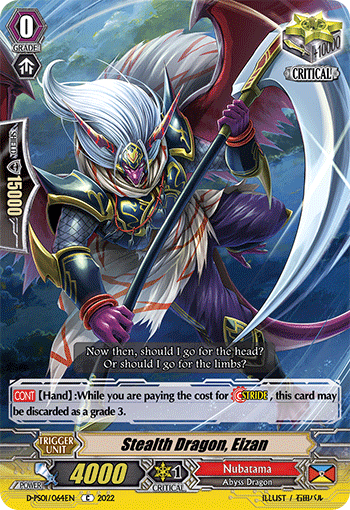 Noroi is the regular source of soul for the deck, not counting re-rides, so he’s a mandatory four-of. Because he shares a name with the sentinel critical trigger, you’re forced into using Mijingakure.
Noroi is the regular source of soul for the deck, not counting re-rides, so he’s a mandatory four-of. Because he shares a name with the sentinel critical trigger, you’re forced into using Mijingakure.
Most decks run four of Mumyocongo, since the value of grade 3 heal guards is too important to not maximize. However, even with Noroi and proper soul management, you may not have enough soul to do what you want during a game. As such, I think Quesera Basara is a reasonable one-of tech. You want to have Mumyocongo for the early defense, to pay for G guard cost, and to use for the cost of superior striding, but having three copies instead of four won’t break anything. There are arguments for and against using Quesera with V Katarigitsune, so use your own judgement and preference to decide.
G Deck
Now, I will quickly touch on each of the G units you could run in the deck. The core of your G units are four Shiranui “Rinne” and two Gedatsurakan. Typically, your best move turn 3 will be superior striding Gedatsurakan, getting two Protect markers, and swatting some cards out of the opponent’s hand. Then, you’ll close the game out with back-to-back Rinne on turns 4 and 5. I already went over the main counter-play against Rinne, but I think it’s less significant than others make it out to be.
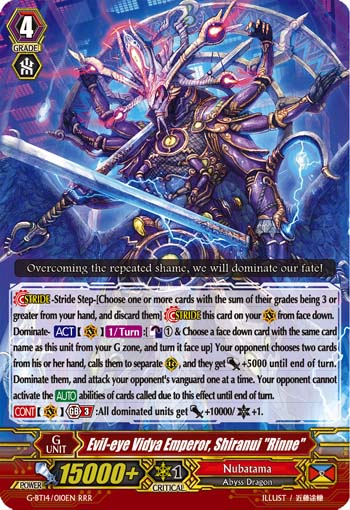 Rinne doesn’t just force the opponent to discard two cards (one of which gives +20000 power), but on GB3 the unit dominated by Oboro or Zanki will get +10000 power, +1 critical, and attack the vanguard. It also gets +5000 because of the Crest, and +4000 if you are on Oboro (could be +4000 if you choose the same unit twice with Zanki), so that’s a total of +19000 and a critical to one unit which will swing at the vanguard. Prior to the Deckset, you only gave the dominated unit +14000. Even a grade 3 can be guarded with one card. With the Crest, that extra +5000 forces the opponent to either G guard or use two cards to guard.
Rinne doesn’t just force the opponent to discard two cards (one of which gives +20000 power), but on GB3 the unit dominated by Oboro or Zanki will get +10000 power, +1 critical, and attack the vanguard. It also gets +5000 because of the Crest, and +4000 if you are on Oboro (could be +4000 if you choose the same unit twice with Zanki), so that’s a total of +19000 and a critical to one unit which will swing at the vanguard. Prior to the Deckset, you only gave the dominated unit +14000. Even a grade 3 can be guarded with one card. With the Crest, that extra +5000 forces the opponent to either G guard or use two cards to guard.
You can estimate that Rinne will rip a minimum of three cards out of the opponent’s hand by striding and using his skill. Once you move to the battle phase with your restanders and +15000-20000 to your front row, Rinne’s presence is overwhelming regardless of whether he dominates something or not. If you happen to get an extra dominate or two, that’s just the cherry on top.
That leaves ten cards to fill the G deck (nine if you exclude Harmonics Messiah), so let’s go over what else Nubatama has to offer. Keep in mind that for 80% of your games you will not stride any of these G units, so their value comes from being played in specific, infrequent situations.
Strides
With the Deckset, there are two types of Shiranui “Mukuro” you can play. Both require soul and activate at GB2, but dominate the opponent’s vanguard and give you one Twin Drive’s worth of triggers you can put on a Fuurai or Sekiei. Because neither of them need a counter-blast (and every other G unit besides Gedatsurakan needs a counter-blast to work), these two come up whenever you need a mid-to-late game stride and don’t have any open damage. This happens if the opponent damage denies you to prevent Rinne, or focuses their attacks on your rearguards. While we can include a source of counter-charge in the main deck, it doesn’t hurt to have a G unit with an alternative cost for games when you don’t draw them.
G Mukuro requires two soul and a discard which can be pretty harsh, but you flip a card in your G zone for part of the cost and attack the opponent’s entire board. If, by turn 4, the opponent is still at low damage and has a full field, G Mukuro can deal with it swiftly. He works as effective counter-play for when the opponent commits their hand to board to rush and guards everything you attack with. When they spread themselves too thin, curb-stomp them in response. Because of the relatively high cost, you can’t stride into G Mukuro without being prepared to go into him; make sure you have enough soul, and a healthy hand to pay the discard cost. You have to look a turn ahead.
The cheaper option is D Mukuro. This version doesn’t flip a card in the G zone, so you miss out on half a turn’s worth of Crest power, but you get an extra attack on the opponent’s vanguard to compensate. At a minimum, his skill reads “Soul-blast 1, draw two cards, retire one of your opponent’s rearguards, and your opponent chooses one card from their hand and discards it”. That’s alright. If your opponent is ahead and you’re not in the position to properly push with Rinne, this Mukuro can accomplish a lot of things at the same time by bringing you and the opponent to more equal ground.
However, note that this version has a different type of stride cost: you have to discard a “Demon Stealth Dragon, Shiranui”. Zanki can be used for this cost along with Oboro. Since this stride isn’t the kind of card you’d actively search the cost for, it’s probably best to only run this Mukuro in decks which run either multiple copies of Zanki, or D Katarigitsune which can directly search for another Oboro.
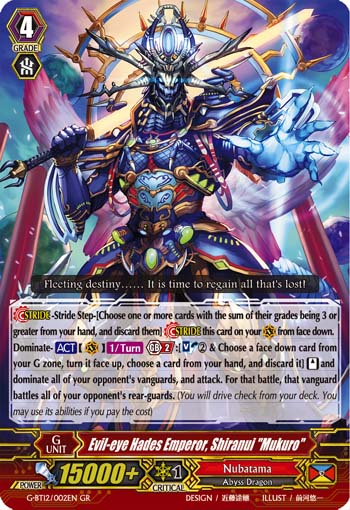 Mujinlord “Dagoku” calls the cards from the opponent’s G zone to attack, which means that you can guarantee two dominate swings regardless of the opponent’s hand. Against a Protect deck which can hoard their markers, Dagoku offers a reliable, consistent push turn. He’s also super effective against decks with a superior stride like Nubatama. Going second, you can steal the two cards they stride in the G zone and swing with each of them for 20000. Zanki combined with Dagoku as the first stride generates four dominate swings, which means Fuurai is 35000 with the Crest.
Mujinlord “Dagoku” calls the cards from the opponent’s G zone to attack, which means that you can guarantee two dominate swings regardless of the opponent’s hand. Against a Protect deck which can hoard their markers, Dagoku offers a reliable, consistent push turn. He’s also super effective against decks with a superior stride like Nubatama. Going second, you can steal the two cards they stride in the G zone and swing with each of them for 20000. Zanki combined with Dagoku as the first stride generates four dominate swings, which means Fuurai is 35000 with the Crest.
Tsukumorakan is a quick finisher when Rinne isn’t enough to finish the job. In the case you are unable to make the opponent discard much but their damage is still high, you can potentially catch the opponent off-guard by striding this card. Be careful with timing: when you stride Tsukumorakan, use his skill first to put them down to four cards, then use Oboro or Zanki’s stride skill and force the opponent to either guard and have three cards in hand, or take it and go to four or five damage, where they have to deal with a +15000-20000 front row with only four cards in hand. Because of the massive CB2 cost, you can’t stride into Tsukumorakan on a whim; like G Mukuro, you have to know a turn in advance that you might use him, and manage your resources accordingly.
Base(d) Mujinlord gets better when the opponent has more rearguards than expected, which could happen by turn 4. Because of the Crest, the +4000 to each of the opponent’s rearguards turns into +9000, which means every unit on their board needs to be blocked regardless of grade.
Also, the attacks don’t need to hit to be effective. Mujinlord’s skill can generate four or five dominates, so on top of your stride dominate Fuurai will be massive. Even with three G units face-up Fuurai starts at 25000, gets +15000 from the Crest and another +5000-10000 depending on whether you rode Zanki that turn. If you have two Fuurai up front, and your opponent’s at five damage, your opponent has to pray for an over trigger to live.
I like Yatsukalord. Double-bind effects like his are always lots of fun. However, in practice he functions as a panic button. Because of the lack of G flip, Yatsukalord is best in games where you whiff the Crest and need to build hand very quickly, such as if the opponent rushed you early. In games like that it’s possible that still won’t be enough, but he’s still your best shot at high-rolling back into a good position. If you’re gonna lose anyways, why not?
While Jakumesso himself is free, there is an invisible counter-blast cost because you need Yamishibuki to get the Evil Decoy tokens. There are some grade 1 units which create two tokens, but their costs are too heavy and they don’t have the versatility of Yamishibuki, and because of the lack of grade 1 space it’s difficult to justify their inclusion. Either way, Jakumesso isn’t “free”. The other catch is that Jakumesso bounces all of your rearguards to hand. This means you can’t restand Fuurai or Sekiei, and your attack pattern will be weaker than if you only bounced some rearguards, and stood the rest. You still get a fourth or fifth attack by calling, and some benefit from either restander like the +5000 power boost from Fuurai (+10000 with Zanki) or the draw from Sekiei if Jakumesso is your second stride.
Because of this anti-synergy, Jakumesso works as a catch-up card like Yatsukalord while you’re behind. It’s for when you have Yamishibuki, the rest of your hand is crap, and you need a way of pressuring the opponent while retaining enough advantage to last another turn. Jakumesso does an excellent job at doing this; you get a +2 while flipping a card in your G zone, a lethal vanguard, and the ability to reset your board. One tricky thing you can do is use Seiengeki multiple times: instead of going for five attacks, you call a column with Seiengeki and use his discard ability after Jakumesso swings. If you had Fuurai or Sekiei you would have strode into something else, so being on on Jakumesso implies your soul is open to use.
G Guardians
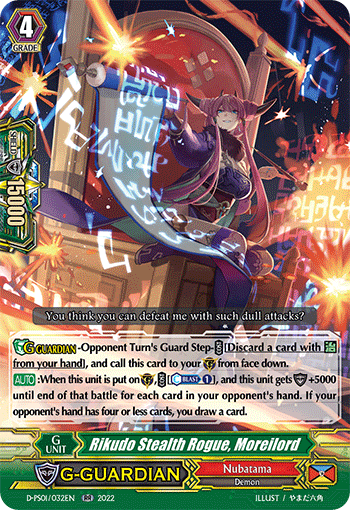 You typically run four or five G guardians in the G deck. One key to playing these cards well is that they are all influenced by the opponent’s attack pattern. Most of them depend on the number of cards in the opponent’s hand, which means they’ll change depending on whether they are played before or after the opponent’s vanguard swing. To play them effectively, you should predict how your opponent attacks and time your G guards accordingly. However, that can only come with practice and experience.
You typically run four or five G guardians in the G deck. One key to playing these cards well is that they are all influenced by the opponent’s attack pattern. Most of them depend on the number of cards in the opponent’s hand, which means they’ll change depending on whether they are played before or after the opponent’s vanguard swing. To play them effectively, you should predict how your opponent attacks and time your G guards accordingly. However, that can only come with practice and experience.
At many points in a game, Moreilord is almost like a pseudo-sentinel. With five cards in the opponent’s hand Moreilord will get an additional +25000 shield, putting your vanguard up to 53000. For comparison, a critical sentinel only puts you up to 43000. This is enough against most attacks, and any larger attacks will only need another card to guard. The extra draw if they have four or less cards is just a bonus.
If the opponent is aware of Moreilord, then they will likely attack with their vanguard last before they perform drive checks so it doesn’t add to her shield. Think about whether her being stronger after the opponent’s vanguard swing is worth saving her.
The standard Nubatama G guard. Most of the time, your opponent will have between three and six cards during the battle phase, so Gandokurakan covers most situations. He’s a staple one-of, but having two would be justifiable.
Abudataishi is technically weaker than Gandokurakan, since his ceiling for shield is lower. However, because we play a deck which drags games out, there will be many games where the opponent does their final push and only has one or two cards left. On those turns, Abudataishi can cover bigger rearguard attacks that none of the G guards can cover without paying a cost. Not strictly necessary in the G deck, but if you were to put in a second Gandokurakan, consider using one Abudataishi instead.
If your opponent is not careful, Gehourakan can completely ruin your opponent’s battle phase preparations. Sniping your opponent’s grade 1 boosters can come in clutch, especially with the prevalence of ride fixers and their attack-while-boosted skills. However, needing a counter-blast and soul-blast makes him rather high-costed, and depending on your opponent’s deck and awareness of Gehourakan they may may be happy to call only grade 0 units to the back row. It’s best to keep him as a situational one-of.
Zashikihime is not run in most decks right now, but I hope you can see why she’s more important in a Crest and discard-focused version of Shiranui. The G flip in the cost implies you would want to run five or six G guards, so build with her in mind.
Never call her if you need to have that extra 20000 shield; depending on how many cards the opponent has in hand, you might not get that shield. If they have a rather large hand (at least eight cards), they might discard something extra they don’t need. We would want to get rid of the opponent’s hand at that size, so that’s okay. On the flip side if they have only one or two cards in hand, they may discard because they feel they won’t survive on the following turn, so they might as well make it harder for you. The sweet spot is when they have a moderately sized hand (between five and seven) and want to hold on to all of it to live the next turn. She is also best on attacks for which she doesn’t totally cover the attack, but the 20000 shield would over-guard it. Make the opponent think about it. You benefit either way.
Conclusion
 If it isn’t clear just from the length, there’s a lot of depth to Nubatama in Premium and I only scratched the surface here. There’s more to cover, but I hope that this at least gives you a good starting place for getting into Premium Shiranui and discovering more about the deck on your own. This is not a bible, and I’m sure that some of what I said here might turn out to be wrong after other players explore the clan post-Deckset. I am constantly learning new things about the clan. What I am absolutely confident about, though, is that Nubatama is about to enter a kind of Renaissance period, and is the most experimental it has ever been. The deck’s about to be tossed into the air and scattered, and this article is just an attempt to guess how it all might fall. The deck will change after February, and I’m excited to see how.
If it isn’t clear just from the length, there’s a lot of depth to Nubatama in Premium and I only scratched the surface here. There’s more to cover, but I hope that this at least gives you a good starting place for getting into Premium Shiranui and discovering more about the deck on your own. This is not a bible, and I’m sure that some of what I said here might turn out to be wrong after other players explore the clan post-Deckset. I am constantly learning new things about the clan. What I am absolutely confident about, though, is that Nubatama is about to enter a kind of Renaissance period, and is the most experimental it has ever been. The deck’s about to be tossed into the air and scattered, and this article is just an attempt to guess how it all might fall. The deck will change after February, and I’m excited to see how.
I’m ready to jump off the stage of Kiyomizu temple, without fear. Are you?
